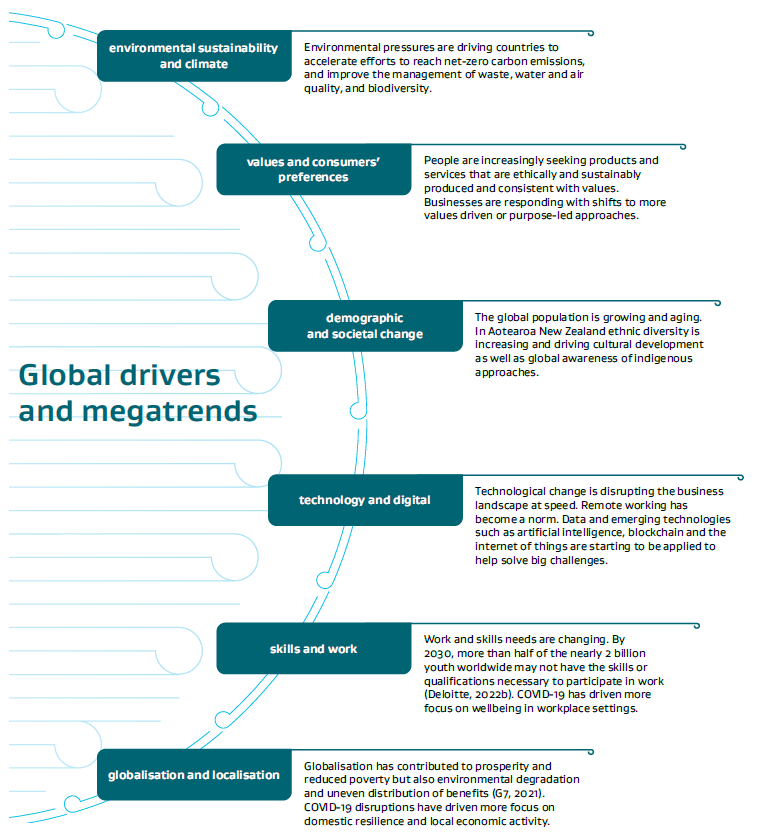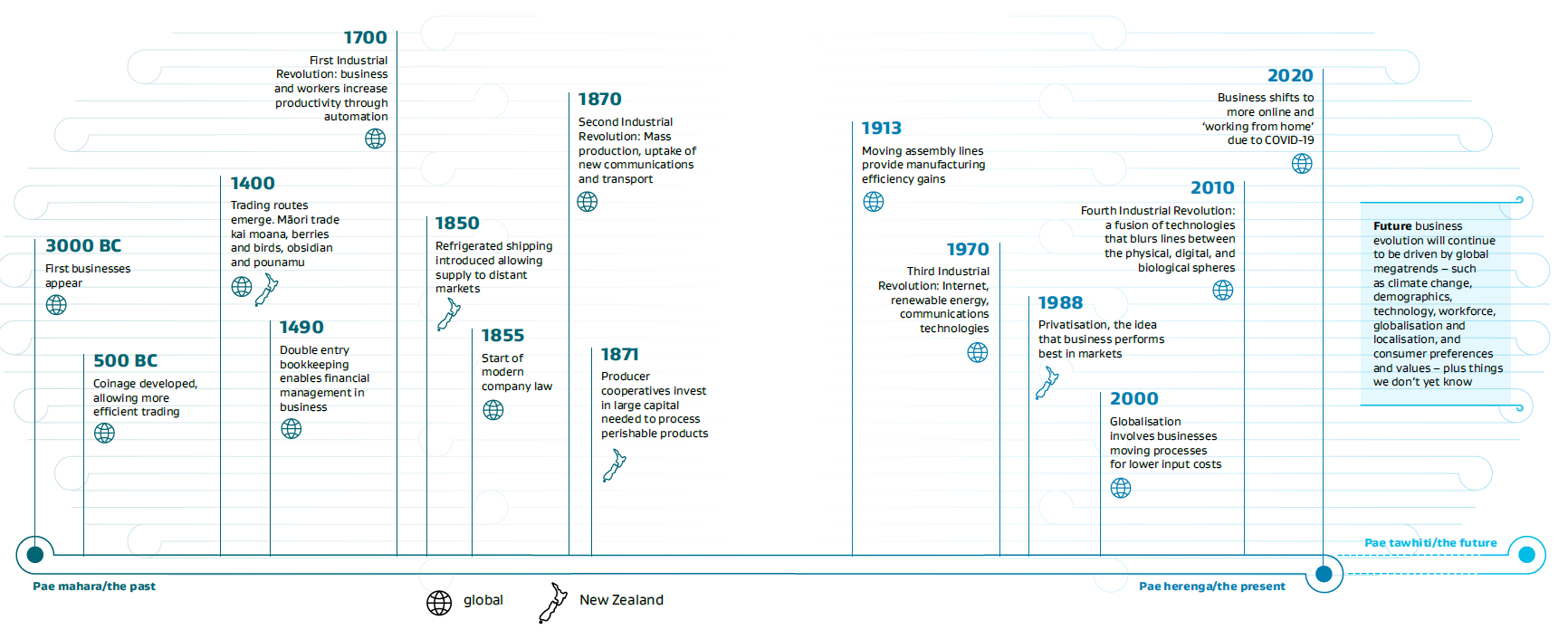1. Introduction
On this page
1.1. Developing long-term insights about the future of business for Aotearoa New Zealand
This Briefing shares ideas about the future of business for Aotearoa New Zealand. It is the product of work led by MBIE as its first Long-term Insights Briefing (Box 1).
In it you will read how business is changing in response to global drivers and megatrends and take a deep dive into two trends – the growth of purpose-led business and the emerging use of blockchain technology.
We then share some long-term insights about how business in Aotearoa New Zealand may change over the next 10 years and beyond, the implications this may have for productivity and wellbeing, and some strategic choices that arise for government.
This Briefing has been developed through engagement and analysis, and with the use of futures thinking tools (see Annex One for more detail on methods). It has also drawn on Māori concepts about time and the interconnections between the past, present and future. Each section presents information in three time horizons:
- Pae mahara – the past, to remember or bear in mind
- Pae herenga – the present, an obligation or connection, which for this work refers to the challenges and opportunities arising from megatrends
- Pae tawhiti – the future, or in the long-term.
Box 1: What is a Long-term Insights Briefing?
Departmental chief executives are required to publish Long-term Insights Briefings at least once every three years. This is a requirement of the Public Service Act 2020. The purpose of the Briefings is to share:
- information about medium and long-term trends, and risks and opportunities that affect or may affect New Zealand and New Zealand society
- information and impartial analysis, including policy options for responding to these matters.
Long-term Insights Briefings are submitted to the House of Representatives. They are not government policy and are prepared independently of ministers.
The Briefings provide an opportunity to enhance public debate on long-term issues and to usefully contribute to future decision-making — not only by government but also by Māori, business, academia, not-for-profit organisations, communities and the wider public.
1.2 A context of change
COVID-19 pandemic has shown us how the future is inherently uncertain and hard to predict. What we do know is that global drivers will continue to shape our economy and society, presenting both challenges and opportunities for Aotearoa New Zealand. Figure 1 below displays some of the global drivers and megatrends that we heard through our consultation were impacting people and business, both globally and in Aotearoa New Zealand.
Figure 1: Some global drivers and related megatrends

Text of figure 1.
1.2.1. Business strategy is evolving to respond to change
Businesses are adapting to respond to risks and to capture opportunities associated with these major changes. This includes developing new products and services, considering environmental and social impact and more ethical ways of working, using new technology, and responding to changes in worker, investor and consumer demand caused by shifting demographics and value systems.
These kinds of changes in business are not new or unusual. Since its beginnings, business has evolved in role and form in response to new technologies or paradigm shifts in the way business is done. Figure 2 shows some events in the evolution of business over time.
External forces and trends immensely shape the way businesses contribute to society. A once-in-a- century global pandemic, economic inequality, changes brought about by major trends in science and technology, education, lifestyle and life expectancy all determine the role of business in society – New Zealand Trade and Enterprise (NZTE)
1.2.2. Governments are broadening focus to wellbeing
Increasingly, governments are realising a sole focus on growth or productivity will not address the challenges presented by global drivers and will not achieve all the outcomes that society wants. An emphasis on sustainability and wellbeing is becoming more commonplace worldwide. This is highlighted by the United Nations (UN) member states’ ambitious Sustainable Development Goals that aim to end poverty, promote peace, share wealth, and protect the planet by 2030. The COVID-19 pandemic has also provided countries with a once-in-a-generation opportunity to reset their economies. Many, such as the European Union (EU), United States (US) and South Korea, have plans to ‘build back better’.
Aotearoa New Zealand is also developing a focus on wellbeing which considers a range of outcomes beyond productivity (Box 2).
Box 2: The Living Standards Framework focuses on wellbeing
Treasury published the first Living Standards Framework in 2011. It expresses a broader approach to living standards than Gross Domestic Product (GDP). It includes financial/physical, human, social and natural capital. The 2021 version of the Living Standards Framework also includes three levels of wellbeing, as follows:
- Our individual and collective wellbeing: the things that are important for our wellbeing as individuals, families, whānau and communities.
- Our institutions and governance: the role our organisations play in facilitating the wellbeing of individuals and collectives, as well as safeguarding and building our national wealth.
- The wealth of Aotearoa New Zealand: how wealthy we are overall, including wealth not fully captured in the system such as human capability and the natural environment.
1.2.3. How do we understand and navigate this change?
The scope and magnitude of the changes outlined above are profound. Just like the major changes that came before, they will affect how we live our lives in ways that are difficult to imagine. To navigate change successfully, we need to understand its patterns and think about what we may need to do over the coming years to guide us to long-term success.
In this Briefing, we tackle these difficult questions by delving into two trends: growth in purpose- led business and the emerging use of blockchain technology.
The two trends are very different, and they do not represent all change that is occurring. But by looking at two different trends we hope to generate insights about the future of business for Aotearoa New Zealand to help guide long-term actions by government.
Box 3: Two deep dives into changes that will affect future business
Purpose-led business
Although it is not revolutionary for businesses to enhance their purpose beyond profit, it is becoming more mainstream and even an expectation among consumers and investors.
A wider purpose will look different for each business — but it can generally be understood to be contributing to or taking responsibility for an aspect of wellbeing beyond financial benefit for the business and its stakeholders.
In this Briefing we discuss the evolution of purpose-led businesses and ask the questions:
- What are the wider implications of growth in purpose-led business?
- What might the future role of business be in contributing to wider productivity and wellbeing?
We also explore some choices governments might have to encourage, incentivise or drive this trend.
Use of blockchain technology
The 2020s is likely be a decade of unprecedented speed and scope of technological change. A period of change like this presents enormous opportunities and challenges to business, for example to lift productivity by shifting to digital functions. It also presents choices for business and government about how technological change may be governed and shaped.
In this Briefing we explore the emerging use of blockchain technology for a broadening range of applications including new business organisational forms.
The opportunities and challenges arising from this trend are presented along with some choices government could consider to enable responsible use of blockchain and leverage its potential for Aotearoa New Zealand.
Figure 2: Business evolution over time

Text of figure 2.

